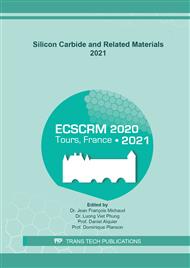p.642
p.647
p.653
p.658
p.663
p.669
p.676
p.683
p.688
Robustness of Semi-Superjunction 4H-SiC Power DMOSFETs to Single-Event Burnout from Heavy Ion Bombardment
Abstract:
We compare the failure mechanism and performance of a silicon carbide (SiC) semi-superjunction (semi-SJ) power DMOSFET against pure SJ and conventional DMOSFET when struck by a single heavy ion. The Single-Event Burnout (SEB) failure mechanism was identified as the thermal runaway from second breakdown resulting in mesoplasma formation. The semi-SJ design shifts the mesoplasma location from the drift/substrate interface seen in the control device structures to a location along the center of the P-pillar and closer towards the DMOSFET surface, thus significantly improving the SEB threshold voltage (VSEB). The VSEB varies with pillar width and ratio of pillar thickness to drift layer thickness. A maximum value of VSEB is reached when the pillar to drift layer ratio is 0.9 and the pillar width is 2.4 μm. The semi-SJ SEB/breakdown voltage ratio is 100% and 13% higher than the pure SJ and conventional DMOSFET, respectively. Using a new Figure of Merit (FoM), which accounts for the tradeoff between VSEB and on-state performance, we find that the SiC semi-SJ DMOSFET achieves a FoM that is 1.8 and 8 times higher than SJ and conventional DMOSFET, respectively, making the semi-SJ a competitive candidate for radiation hardened applications.
Info:
Periodical:
Pages:
683-687
Citation:
Online since:
May 2022
Authors:
Permissions:
Share:
Citation:


